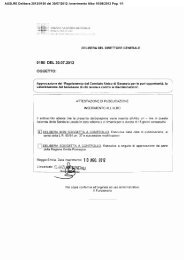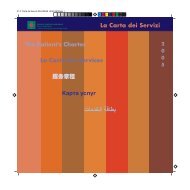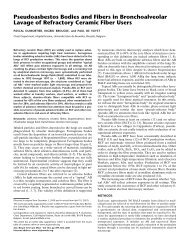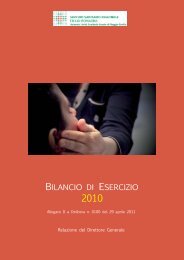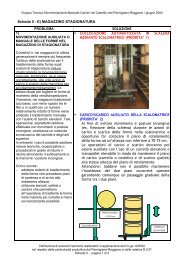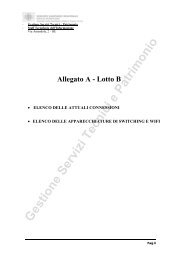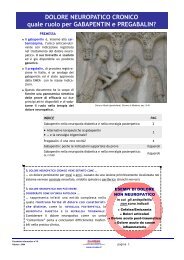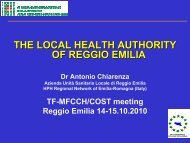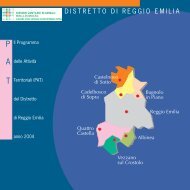Download PDF
Download PDF
Download PDF
- No tags were found...
You also want an ePaper? Increase the reach of your titles
YUMPU automatically turns print PDFs into web optimized ePapers that Google loves.
Home-based interventions for postpartum depression 7Table 2 Depression measures, type of analysis, and results of included studiesStudy Depression measures Intention-totreatanalysisResultsAppleby et al.1997Chabrol et al.2002Cooper et al.2003Holden et al.1989Prendergast andAustin, 2001Wiggins et al.2005EPDS Yes Immediately post-intervention, all 4 groups showed significant improvementHAM-Don the Revised Clinical Interview ScheduleRevised Clinical InterviewSchedule6 sessions of CBT were more effective than 1 session on the Revised ClinicalInterview Schedule and HAM-D but not on the EPDSBDI Yes a Immediately post-intervention, women in the intervention group had reducedEPDSscores on all measures compared to women in the control groupHAM-DThere was a 60% difference in recovery rate between the intervention andcontrol groups favoring the interventionEPDS Yes Immediately post-intervention, women in all 3 intervention groups had lowerEPDS scores compared to women in the control group and women in thepsychodynamic therapy group had lower rates of depression compared towomen in the control groupAt 9, 18, and 60 months postpartum, none of the intervention groups differedsignificantly from the control group on either measureEPDS No Immediately post-intervention, women in the intervention group had aStructured Clinicalsignificant reduction in mean scores from baseline on both measuresInterview for DSM-III-Rcompared to women in the control groupThere was a 32% difference in recovery rate between the groups favoringinterventionEPDS No There were no significant differences between the groups on any of theGoldberg’s Standardizedmeasures immediately or 6-months post-interventionPsychiatric InterviewMADRSEPDS Yes There were no significant differences between the intervention and controlGHQgroups immediately or 6-months post-interventionBDI Beck Depression Inventory; EPDS Edinburgh Postnatal Depression Scale; GHQ General Health Questionnaire; HAM-D HamiltonDepression Rating Scale; MADRS Montgomery-Asberg Depression Rating Scalea All subjects in both groups completed the treatment protocol and were re-assessed post-interventionintervention or routine care. Women in the interventiongroup received an average of 8.8 sessions of non-directivecounseling for at least 30 min delivered by a health visitortrained in the methods of this psychological intervention.Immediately post-intervention, results indicated that 69% ofwomen in the intervention group and 38% of women in thecontrol group had recovered from depression. In addition,women who received the intervention had a significantreduction in mean scores on the EPDS and Goldberg’sStandardized Psychiatric Interview compared to womenreceiving routine care. However, some participants weretaking antidepressants during the study period, and antidepressantuse was not controlled in analyses, possiblyleading to bias in these results. In addition, the authorsdid not conduct intention-to-treat analyses.Findings from a larger trial of non-directive counselingconducted by Wiggins et al. (2005) differed from thosereported by Holden et al (1989). In this selective preventiveintervention, women living in deprived areas of Londonwere randomized to routine care or an interventioncondition consisting of monthly home-based non-directivecounseling sessions delivered by health visitors. Over the12-month duration of the study, women in the non-directivecounseling intervention group received an average of 10 hof support in seven home visits and additional contacts overthe phone. Immediately post-intervention, there were nodifferences in depressive symptoms, as assessed by theEPDS, between women randomized to the home-basednon-directive counseling intervention and women randomizedto routine care. The same results were found sixmonthspost-intervention when depressive symptoms weremeasured with the General Health Questionnaire (GHQ;Goldberg and Williams 1988). However, neither the use ofroutine health visiting services available to women in thecontrol condition nor baseline depressive symptoms orsociodemographic characteristics were accounted for in theanalyses, and different measures were used to assessdepressive symptoms immediately post-intervention and atthe 6 month follow-up.Overall, these two studies suggest that non-directivecounseling may be an effective treatment for PPD but maynot be as effective when used as a selective preventiveintervention. This pattern of findings may reflect design andmethodology differences between the Wiggins et al. (2005)study and the Holden et al. (1989) study beyond those dueto the different types of interventions employed. First,



